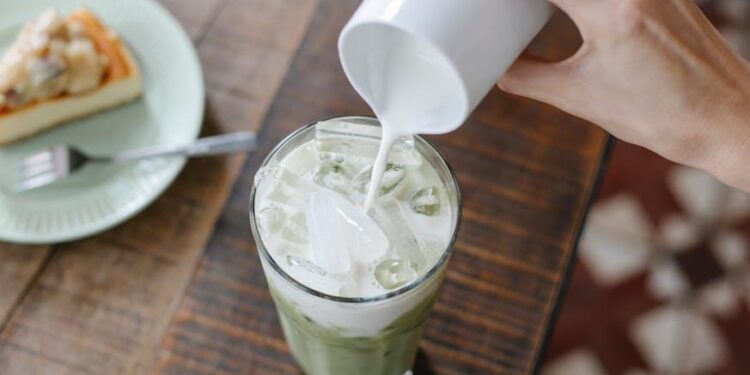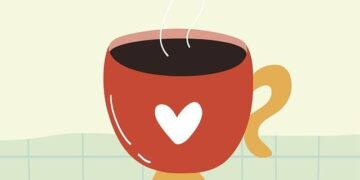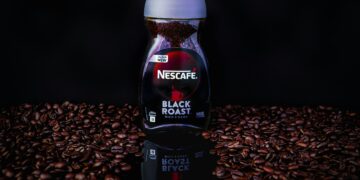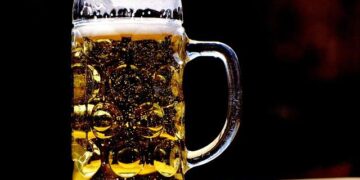Table of Contents
Introduction: The Daily Grind and the $7 Question
The ritual is familiar to millions: the morning coffee R.N. For many, it has devolved into a low-grade, high-cost form of daily punishment.
The experience often involves a long, snaking line of cars, inching forward with agonizing slowness.
There is the anxiety of trying to convey a complex order through a crackling, impersonal speaker, followed by the uncertainty of whether the drink will be made correctly.
The interaction at the window can be a lottery—sometimes a brief, transactional exchange, other times a moment with a barista who seems as stressed and overworked as the customers they serve.
At the end of this gauntlet, a beverage is exchanged for a sum approaching $7, leaving a lingering question: Was the satisfaction received worth the time and stress expended?
This common frustration forms the backdrop for a quiet revolution brewing in the quick-service restaurant (QSR) industry.
An encounter with a 7 Brew coffee stand can be a jarringly different experience.
The first impression is one of organized chaos: music playing, employees dancing, and two lanes of cars moving with surprising velocity.
A friendly team member, or “Brewista,” approaches the car far from the window, iPad in hand, taking the order with a smile.
Moments later, at the pickup window, the correct drink is ready.
The price is comparable to the premium competition, but the experience is from another dimension entirely.
This contrast prompts a deeper investigation.
What is the secret behind the 7 Brew machine? What does its pricing model truly represent?
The answer is that 7 Brew’s prices, while similar to those of other premium coffee chains, are not for a simple commodity.
They are the entry fee to a revolutionary service model—a high-performance system meticulously engineered to solve the core frustrations of the modern consumer.
This report deconstructs that system, using the powerful analogy of a Formula 1 pit stop to reveal how 7 Brew is not just selling coffee, but selling time, joy, and consistency at a scale that is rapidly reshaping the market.
Section 1: The Anatomy of the Modern Coffee Dilemma: Why Your Morning Coffee Run is Broken
Before one can appreciate the elegance of 7 Brew’s solution, it is essential to diagnose the pervasive problems it was designed to solve.
The modern coffee shop experience, particularly in the drive-thru format, is rife with systemic failures that create friction for both customers and employees.
These are not isolated incidents but recurring patterns of a service delivery model that is frequently inefficient, stressful, and emotionally draining.
The market gap that 7 Brew so expertly exploits is born from this widespread dissatisfaction.
The Tyranny of the Queue
The most immediate and universal pain point is the wait.
Long lines are a physical manifestation of inefficiency, creating a psychological and practical cost for customers who are often on their way to work or managing a tight schedule.1
This waiting period is fertile ground for impatience and frustration, setting a negative tone for the entire interaction before a single word is exchanged with a barista.2
The drive-thru, intended to be a bastion of convenience, often becomes a trap, where the time commitment is unpredictable and the escape route is nonexistent.
The Service Lottery
The quality of human interaction at a typical coffee shop is wildly inconsistent.
Customers may encounter “snippy baristas” who are curt and unhelpful, or they may be met with a robotic, disengaged demeanor that makes them feel like just another transaction.3
This is often a symptom of a larger problem: the immense emotional labor demanded of service workers who are instructed to be perpetually upbeat, a phenomenon that can lead to burnout, inauthenticity, and even mental health challenges.4
When a customer does have a genuinely pleasant interaction, it feels like a lucky exception rather than the standard, highlighting the systemic failure to create a sustainably positive work environment that naturally translates to better customer service.
The Paradox of Choice and Quality
Many coffee chains present customers with enormous, complex menus that include not only coffee but also boba, smoothies, and a dizzying array of sugary, dessert-like lattes.3
This “paradox of choice” can be overwhelming, and the quality is often a gamble.
Consumers frequently complain about overly sweet drinks that taste more like a “fancy milk” with a “coffee hint” than a genuine coffee beverage.5
The reliance on artificial syrups and sweeteners can leave a “gross filmy feeling” or a distinct “chemical taste” in the mouth, a far cry from the satisfying experience a premium price should command.5
One Reddit user estimated that the rate of disappointment at coffee shops is as high as 50%, a staggering figure suggesting that the industry often prioritizes novelty and sugar over the fundamental quality of its core product.6
Atmospheric Failures
For customers who venture inside, the physical environment itself is often a source of frustration.
Common complaints aggregated from online forums paint a bleak picture: obnoxious music played at jarring volumes, a glaring lack of electrical outlets for those looking to work, uncomfortable or impractical furniture like backless stools, and a general state of uncleanliness.3
The ambiance, which should be warm and inviting, can instead feel “clinical and morgue-y,” completely undermining the “café culture” these establishments claim to foster.3
These failures demonstrate a fundamental misunderstanding of what customers seek in a third space: comfort, functionality, and a welcoming atmosphere.
The problem, therefore, is not merely the coffee; it is the entire service ecosystem that is fundamentally broken.
Section 2: The Pit Stop Epiphany: Deconstructing the 7 Brew Machine
The realization that dawns upon observing 7 Brew in action is that it does not operate like a traditional coffee shop.
It operates like a Formula 1 pit stop.
This is not a superficial comparison; it is the central organizing principle behind the company’s success.
An F1 pit stop is a globally recognized symbol of speed, precision, advanced technology, and highly coordinated teamwork, all choreographed to shave precious seconds off a process where every moment is critical.
7 Brew has taken these core principles and applied them to the drive-thru coffee experience, creating a system where each component radically enhances the others.
Component 1: The Double-Lane Racetrack (The Physical Infrastructure)
The most visible innovation is the physical layout.
Every 7 Brew location is a drive-thru-only business featuring canopied double lanes.8
This is not simply about adding a second service line; it is a strategic design choice that immediately doubles the system’s throughput capacity.
Much like a multi-lane racetrack, it allows for parallel processing, reducing bottlenecks and creating a powerful sense of constant forward momentum for the customer.
The anxiety of being stuck behind a single indecisive customer or a large, complex order is immediately mitigated.
Underpinning this design is an even more critical, though less visible, innovation: modular construction.
7 Brew’s unique buildings are fabricated in a warehouse and then shipped to the site for final connections.10
This “modular chassis” approach provides a staggering competitive advantage.
It dramatically reduces the time and cost of construction, allowing for incredible speed-to-market and perfect replication of the “pit stop” environment across a rapidly expanding network of hundreds of locations.8
This standardization is the key to scaling a consistent, high-performance experience, a challenge that often plagues franchise models reliant on traditional, variable construction methods.
Component 2: The Pit Crew and The Tablet (The Human-Tech Interface)
If the dual lanes are the racetrack, the “Brew Crew” is the high-performance pit crew.
The lynchpin of the entire human process is the “runner” who walks into the queue to greet customers with an iPad.8
This single action brilliantly subverts the traditional drive-thru model.
It moves the point of first contact away from a static, impersonal speaker box and creates a face-to-face interaction early in the process.
This is not just about taking an order; it is a strategic maneuver that accomplishes several goals simultaneously.
It starts the production clock ticking sooner, personalizes the experience from the outset, and allows the crew to triage and manage the flow of orders with greater efficiency.
This human element is powered by a sophisticated, data-fueled engine.
Over 90% of all 7 Brew transactions occur through its loyalty program, which is tied to a customer’s phone number.8
When a Brewista enters that number into their iPad, they gain instant access to a dashboard of customer telemetry: order history, drink preferences, milk alternatives, and even noted allergies.8
This transforms a generic transaction into a highly personalized and efficient interaction.
A regular customer can be greeted with, “The usual Blondie today?” This seamless integration of human touch and accessible data is the technological soul of the pit stop, ensuring both speed and accuracy.
Once the order is confirmed, it is instantly relayed to the production screens inside, where the internal crew can see exactly which car it belongs to and its position in the queue, ensuring the drink is ready the moment the car reaches the window.8
Component 3: The Performance Philosophy (The Culture)
A pit stop executed with flawless technical precision but no spirit would feel cold and robotic.
7 Brew’s final, and perhaps most important, component is its culture.
The company’s official mission is to “cultivate kindness and joy with every drink”.11
This is not corporate marketing fluff; it is a core operational directive.
The high-energy atmosphere, the music, the dancing baristas—these are all deliberate elements of the “mind-blowing experience” the brand aims to deliver.13
This cultivated positivity serves a critical function: it is the human face of the hyper-efficient machine.
It ensures that customers feel energized and valued, not just processed.
This focus on kindness and joy is what turns a transaction into a memorable interaction, forming the emotional bedrock of the brand’s remarkable customer loyalty.
The genius of the 7 Brew model lies in the interconnection of these components.
It is a closed-loop system where the physical design, technological infrastructure, human processes, and cultural philosophy are mutually reinforcing.
The modular buildings enable rapid franchise growth.
That growth is fueled by a model that promises high revenue.
The high revenue is driven by the high throughput of the dual-lane and runner system.
That system is made hyper-efficient by the integrated technology.
And the entire experience is made enjoyable and repeatable by the culture of kindness, which in turn drives the customer retention that makes the business model so attractive in the first place.
Competitors who attempt to copy a single element—like adding a second drive-thru lane—are destined to fail because they do not understand the deeply integrated nature of the system they are trying to emulate.
Section 3: The Price of Joy: A Forensic Analysis of the 7 Brew Menu
With a clear understanding of the sophisticated operational machine 7 Brew has built, it is now possible to analyze its pricing structure in the proper context.
The price of a 7 Brew beverage is not an arbitrary number but the calculated result of the immense value created by its revolutionary service model.
This section provides the hard data on menu prices while framing it within the larger narrative of what a customer is truly paying for.
Subsection 3.1: The 7 Brew Menu and Price List
7 Brew’s menu is extensive, designed to appeal to a broad audience with a mix of classic coffee drinks, signature creations, and a popular line of energy drinks.
The prices are positioned firmly in the premium coffee segment.
It is important to note that prices can vary by location and are often higher when ordered through third-party delivery services like DoorDash, which add their own service fees and markups.14
The following table provides a consolidated overview of estimated prices for standard/medium-sized drinks, based on available 2024 data.
Table 1: 7 Brew Detailed Menu & Price List (2024 Estimates)
| Category | Item Name | Description | Calorie Range | Estimated Price (Medium) | |
| The 7 Originals | Blondie | Caramel & Vanilla Breve | 270-850 | $6.05 – $6.59 | |
| Brunette | Hazelnut & Caramel Mocha | 280-850 | $6.05 – $6.59 | ||
| Smooth 7 | White Chocolate & Irish Cream Breve | 260-840 | $6.05 – $6.59 | ||
| Cinnamon Roll | White Chocolate & Brown Sugar Cinnamon Breve | 300-770 | $6.05 – $6.59 | ||
| White Chocolate Mocha | White & Milk Chocolate Mocha | 280-850 | $6.05 – $6.59 | ||
| German Chocolate | Coconut & Caramel Mocha | 280-860 | $6.05 – $6.59 | ||
| Sweet & Salty | Salted Caramel & White Chocolate Breve | 180-840 | $6.05 – $6.59 | ||
| Classics | Latte | Made with Whole Milk | 120-320 | $5.40 – $5.92 | |
| Mocha | Made with Chocolate Milk | 200-520 | $5.73 – $6.25 | ||
| Breve | Made with Half and Half | 250-660 | $5.72 – $6.25 | ||
| Caramel Macchiato | Made with Whole Milk | 210-850 | $6.05 – $6.59 | ||
| Cold Brew | – | 20-90 | $6.05 – $6.26 | ||
| House Blend | Americano | 10-20 | $3.45 – $3.67 | ||
| Chai Latte | Chai Tea mixed with Whole Milk | 160-400 | $5.73 – $6.32 | ||
| Cocoa | – | 250-630 | $4.10 – $4.28 | ||
| 7 Energy | Seven Energy (Iced) | Premium energy drink, infused with flavor | 10-560 | $6.83 – $7.14 | |
| 7 Energy Can | Can only of 7 Energy | – | $3.99 | ||
| Other Drinks | Smoothies | Strawberry, Mango, Blue Pom | – | $7.05 – $7.75 | |
| Teas | Black, Green, Paris, etc. | – | $3.78 – $5.03 | ||
| Lemonade | – | – | $3.78 – $5.03 | ||
| Seven Fizz | Sparkling water infused with flavor | 0-440 | $3.90 – $5.03 | ||
| Source: Data compiled and synthesized from multiple online menu sources, including DoorDash, reflecting potential regional and third-party variations.14 |
Subsection 3.2: The Value Equation: What Are You Really Paying For?
The price tag for a signature “Original” drink, hovering around $6.50, is not merely for the liquid ingredients in the cup.
It is an all-inclusive fee for the entire “pit stop” experience, a bundle of tangible and intangible benefits that directly address the pain points of the traditional coffee R.N. A customer is paying for:
- Time: The value of a significantly shorter and more predictable wait time, giving back precious minutes in a busy day.
- Certainty: The value of guaranteed consistency. The high-tech, process-driven system dramatically reduces the likelihood of an incorrect order, eliminating the frustration and waste of a poorly made drink.
- Personalization: The value of being recognized. The integrated rewards program creates a feeling of being a known regular, even at a new location, where preferences are remembered and catered to.8
- Positivity: The intangible but powerful value of a genuinely pleasant, high-energy human interaction that can positively impact one’s mood for the rest of the day.11
When viewed through this lens, the price is not an expense but an investment in a frictionless, positive, and reliable experience.
Subsection 3.3: Competitive Grid: 7 Brew vs. The Titans
To fully understand 7 Brew’s market positioning, it is crucial to compare its pricing directly with its main competitors: the market behemoth, Starbucks, and its closest drive-thru rival, Dutch Bros. The data clearly shows that 7 Brew is not a budget option.
Its pricing strategy is to compete squarely within the premium segment, reinforcing the argument that it competes on superior value, not on lower cost.
Table 2: Competitive Pricing Snapshot: 7 Brew vs. Starbucks vs. Dutch Bros.
| Drink (Comparable) | 7 Brew | Starbucks | Dutch Bros. | |
| Mocha | ~$6.25 (16 oz) | ~$5.75 (16 oz) | ~$5.95 (16 oz) | |
| Iced Vanilla Latte | ~$5.92 (16 oz) | ~$6.25 (16 oz) | ~$5.95 (24 oz) | |
| Cold Brew | ~$6.26 (16 oz) | ~$4.95 (16 oz) | ~$4.95 (24 oz) | |
| Signature Blended | ~$6.59 (Blondie, 16 oz) | ~$5.95 (Caramel Frappuccino, 16 oz) | ~$6.65 (Caramelizer, 24 oz) | |
| Source: Prices are estimates based on available 2024 data for medium/grande sizes and may vary by location. Size information is critical for value comparison.14 |
The competitive grid reveals a nuanced landscape.
While some Starbucks drinks appear slightly cheaper, Dutch Bros. often offers a larger serving size for a similar price, though this is often due to more ice rather than more product.16
7 Brew positions itself confidently in this mix.
It does not need to undercut its rivals on price because its core differentiator is not the drink itself, but the revolutionary efficiency and joy of its service model.
Customers are demonstrably willing to pay a premium price for an experience that eliminates the waiting, the uncertainty, and the impersonality of the competition.
Section 4: Engineering Loyalty: How 7 Brew is Winning the Wallet Share War
The “pit stop” model is not just a clever operational theory; it is a ruthlessly effective business strategy that produces quantifiable, market-beating results.
The system’s success is most evident in two key areas: its extraordinary ability to create and retain loyal customers, and its “flywheel” effect on franchise growth.
This section transitions from the “how” of the model to the “what” of its powerful business outcomes, proving that 7 Brew’s solution to the modern coffee dilemma is both highly effective and incredibly profitable.
The Retention Engine
In the competitive QSR landscape, customer retention is the ultimate measure of success.
On this front, 7 Brew is not just winning; it is dominating.
Data from Earnest Analytics reveals a stunning gap in customer loyalty.
Eleven quarters after a customer’s first purchase, an impressive 31% of 7 Brew customers are still actively buying from the brand.
This figure significantly outperforms its closest competitors, with Starbucks retaining 23% and Dutch Bros. retaining only 17% of their customers over the same period.19
This superior retention is the direct, predictable result of the operational excellence and positive experience engineered into the 7 Brew model.
By systematically solving the problems of long waits, inconsistent service, and impersonal interactions, 7 Brew has created a service that customers are eager to return to.
This loyalty translates directly into market share.
The brand’s share of wallet—the portion of a customer’s total coffee spending that goes to one brand—grew by nearly 500% between February 2023 and February 2024.19
More telling is where this money is coming from: over the last year, as 7 Brew customers increased their spending share at 7 Brew from 6% to 21%, their spending share at Starbucks actively decreased by 9%.19
Customers are not just adding 7 Brew to their rotation; they are actively replacing their Starbucks habit with it.
The Franchise Flywheel
This powerful customer loyalty creates a highly attractive business proposition, which in turn fuels 7 Brew’s primary growth engine: its franchise model.
The brand’s “hyper-growth” from just seven stands in 2021 to over 300 by 2024 is a direct result of its successful partnerships with franchisees who are rapidly expanding the brand’s footprint across the country.8
The company has agreements in place to open over 3,000 locations, signaling a long-term, aggressive expansion strategy.8
This rapid growth is predicated on a model that, while requiring a significant upfront investment, is designed to be a high-volume, high-revenue machine.
The initial investment to open a 7 Brew franchise is substantial, reflecting the sophisticated nature of its prefabricated buildings and technology.
Table 3: 7 Brew Franchise Investment & Fees Overview
| Expenditure Category | Minimum Investment | Maximum Investment | |
| Development & Franchise Fee (2-Store Min.) | $45,000 | $45,000 | |
| Building / Build-Out Costs | $318,500 | $525,000 | |
| Site Development Costs | $229,000 | $784,000 | |
| Store Equipment, Fixtures, Furniture | $135,000 | $217,000 | |
| Marketing, Training & Additional Funds | $75,000 | $175,000 | |
| Total Estimated Initial Investment | $890,300 | $1,934,500 | |
| Ongoing Fees | |||
| Royalty Fee (Tiered) | 4.5% – 7% of weekly gross sales | ||
| Brand Fund Contribution | 1% of weekly gross sales | ||
| Source: Data compiled from Vetted Biz analysis of the 7 Brew Franchise Disclosure Document.21 |
Despite the high barrier to entry, the model is highly sought after because of its potential payoff.
In 2023, the median gross sales for a 7 Brew franchise was an impressive $2,182,022.21
This high revenue potential makes the franchise a lucrative opportunity for well-capitalized investors.
Furthermore, the royalty structure itself is a work of strategic genius.
The fee is tiered based on performance: 4.5% of weekly gross sales if sales are below $20,000, rising to 7% if sales exceed $25,000.21
This is not a simple fee; it is a shared-risk, shared-reward partnership.
It creates a powerful incentive for the franchisor to provide exceptional support to help every location surpass the $25,000 weekly threshold, as its own revenue percentage increases significantly.
Simultaneously, it aligns the franchisee’s goals with the franchisor’s, pushing both to maximize the efficiency and revenue of each “pit stop.” This financial alignment creates a self-reinforcing loop that fuels the entire system’s explosive growth.
Section 5: The Cultural Context: Why the 7 Brew Model is Built for This Moment
7 Brew’s success cannot be fully understood by looking at its operations in a vacuum.
Its model is not just operationally sound; it is perfectly tailored to the specific nuances of the modern consumer culture, particularly in North America.
By understanding the cultural landscape, it becomes clear that 7 Brew is not just a successful company but a cultural phenomenon, a solution built for this exact moment in time.
The American Need for Speed (and a Smile)
Historically, American coffee culture has been defined by “speed and quantity”.22
Unlike the leisurely, social coffee traditions of Italy, the American approach has been one of efficiency, a mirror of the nation’s focus on work and progress.22
The rise of remote work has further transformed cafés into functional spaces for productivity, transit, and convenience.23
7 Brew’s entire “pit stop” model leans directly into this deep-seated cultural predisposition for speed and efficiency.
It takes what American consumers already value and elevates it to a level of performance its competitors cannot match.
However, the true brilliance of the model is that it simultaneously provides a powerful antidote to the negative side effects of this efficiency-obsessed culture.
The relentless drive for speed has often led to service interactions that are impersonal, transactional, and emotionally hollow.
7 Brew re-injects a crucial missing element: genuine, positive human interaction.
The brand’s mandate to “cultivate kindness” is a direct response to a societal hunger for connection.
It offers a “have your cake and eat it too” proposition: customers get the speed they crave without the soul-crushing impersonality that usually accompanies it.
Combined with the endless customization options—over 20,000 drink combinations that cater to the American consumer’s desire for personalization and choice—the model becomes a near-perfect fit for the market.8
A Brief Global Detour: Why This Might Not Work Everywhere
To sharpen the focus on why the 7 Brew model is so resonant in North America, a brief contrast with other global coffee cultures is illuminating.
This comparison highlights the specificity of 7 Brew’s market-fit.
- United Kingdom: The UK is a nation where coffee has overtaken tea, but the culture remains distinct. There is a deep-seated love for the practicality and convenience of instant coffee, which accounts for 80% of household purchases.24 The social coffee experience is often more reserved.24 The high-energy, in-your-face friendliness of the 7 Brew “Brew Crew” might not resonate as strongly in a culture that often prizes understatement.
- Australia & New Zealand: The “Down Under” coffee market is one of the most sophisticated in the world. It is a 100% espresso-based market, born from post-WWII Italian migration, with a deeply ingrained focus on quality.25 The market is dominated by independent cafés and local boutique roasters, and there are even compulsory national barista training standards.25 This culture of espresso purists might be skeptical of a high-volume, drive-thru model that places a heavy emphasis on flavored syrups and energy drinks over the nuances of the coffee bean itself.
This contrast is not a critique of other cultures but a testament to 7 Brew’s strategic acumen.
They have not built a one-size-fits-all global model.
They have built a tailored solution for a specific cultural problem in a specific market.
7 Brew’s most potent product is not coffee; it is a moment of positive, efficient human connection, a cultural antidote that has successfully monetized the solution to the alienating side effects of modern life.
Conclusion: The Future of the Drive-Thru Revolution
The journey that began in a frustratingly slow coffee line culminates in a clear and powerful conclusion.
The $7 price of a 7 Brew coffee is not an expense for a simple beverage; it is an investment in a superior experience.
The company’s meteoric rise is not an accident or a fleeting trend.
It is the result of a masterclass in experience engineering, built on a foundation of rigorous systems thinking.
The Formula 1 pit stop is more than a clever analogy; it is the operational blueprint for a company that has systematically diagnosed the ailments of the modern QSR experience and built a holistic, scalable cure.
7 Brew has proven that speed and soul are not mutually exclusive.
By integrating a high-performance physical infrastructure, a smart human-tech interface, and a culture dedicated to “cultivating kindness,” the company has created a service model that delivers on every promise.
It gives customers back their time, provides the certainty of a quality product, offers a moment of personalized recognition, and injects a dose of joy into the daily grind.
The stunning customer retention rates and explosive franchise growth are the logical outcomes of this well-engineered system.
Looking ahead, 7 Brew faces the predictable challenges of scale.
Can the authentic “kindness” culture be maintained as the company expands from hundreds to thousands of locations? How will the brand integrate new technologies like online ordering and third-party delivery without disrupting the finely tuned choreography of its in-person flow—a challenge its leadership acknowledges and is approaching with caution?8 And how will it fend off market titans like Starbucks, who are now openly attempting to emulate its drive-thru-focused strategy in response to its success?19
Despite these challenges, 7 Brew’s position appears strong.
It is more than just a coffee company; it is a pioneer charting the future of customer service.
It has set a new, higher standard for what consumers can and should expect from a drive-thru window.
By proving that efficiency does not have to come at the cost of humanity, 7 Brew is leading a revolution that is likely to ripple across the entire service industry for years to come—a revolution well worth the price of a coffee.
Works cited
- How to Deal with Difficult Customers at a Coffee Shop: Effective Strategies, accessed August 6, 2025, https://majestycoffee.com/blogs/posts/how-to-deal-with-difficult-customers-at-a-coffee-shop-effective-strategies
- Dealing with Frustrated Coffee Shop Customers | TigerChef, accessed August 6, 2025, https://www.tigerchef.com/dealing-with-frustrated-coffee-shop-customers.html
- What are some of your coffee shop icks/pet peeves? (repost) : r …, accessed August 6, 2025, https://www.reddit.com/r/Coffee_Shop/comments/1afielf/what_are_some_of_your_coffee_shop_ickspet_peeves/
- The Problem with Forced Enthusiasm in Specialty Coffee – FLTR Magazine, accessed August 6, 2025, https://fltrmagazine.com/2025/03/21/the-problem-with-forced-enthusiasm-in-specialty-coffee/
- Pros and cons of 7 Brew coffee. Whatcha think? : r/LittleRock – Reddit, accessed August 6, 2025, https://www.reddit.com/r/LittleRock/comments/12ovd34/pros_and_cons_of_7_brew_coffee_whatcha_think/
- Why are so many coffee shops bad? : r/barista – Reddit, accessed August 6, 2025, https://www.reddit.com/r/barista/comments/1i60gzb/why_are_so_many_coffee_shops_bad/
- Why are so many coffee shops bad? : r/espresso – Reddit, accessed August 6, 2025, https://www.reddit.com/r/espresso/comments/1i5ysw1/why_are_so_many_coffee_shops_bad/
- Outstanding Operator: 7 Brew Coffee | Food On Demand, accessed August 6, 2025, https://foodondemand.com/03052025/outstanding-operator-7-brew-coffee/
- 7 Brew’s Remarkable 2024: 300+ Stands, Expanded Leadership and Community Connections – Business Wire, accessed August 6, 2025, https://www.businesswire.com/news/home/20241217562954/en/7-Brews-Remarkable-2024-300-Stands-Expanded-Leadership-and-Community-Connections
- 7Brew – Verdant Studio, accessed August 6, 2025, https://www.verdant-studio.com/commercial-projects/7brew
- About the 7 Brew Coffee Story, accessed August 6, 2025, https://7brew.com/about-us
- 7 Brew kicks off 2024 with unit growth and a mission to cultivate kindness, accessed August 6, 2025, https://www.comunicaffe.com/7-brew-kicks-off-2024-with-unit-growth-and-a-mission-to-cultivate-kindness/
- 7 Brew — kyle kostesich — branding & creative direction, accessed August 6, 2025, https://kylekostesich.com/7brew
- Order 7 Brew Coffee – Columbia, SC Menu Delivery [Menu & Prices] – DoorDash, accessed August 6, 2025, https://www.doordash.com/store/7-brew-coffee-27937893/
- 7 Brew Coffee’s Menu: Prices and Deliver – DoorDash, accessed August 6, 2025, https://www.doordash.com/business/7-brew-coffee-11612012/menu/
- Starbucks Vs Dutch Bros: Who Makes The Better Coffee? – Tasting Table, accessed August 6, 2025, https://www.tastingtable.com/1791209/starbucks-vs-dutch-bros-coffee/
- Starbucks vs. Dutch Bros, which do students pick? – WCHS Insight, accessed August 6, 2025, https://wchsinsight.org/35325/arts-entertainment/starbucks-vs-dutch-bros-which-do-students-pick/
- Dutch bros drink prices? compared to other coffee & drink places & chains – Reddit, accessed August 6, 2025, https://www.reddit.com/r/dutchbros/comments/18or1pt/dutch_bros_drink_prices_compared_to_other_coffee/
- 7 Brew Coffee share grows in 2024 – Earnest Analytics, accessed August 6, 2025, https://www.earnestanalytics.com/insights/7-brew-coffee-share
- Brewing Hypergrowth: How 7 Brew Coffee Built a Scalable Digital Foundation – Bounteous, accessed August 6, 2025, https://www.bounteous.com/events/2025/03/18/brewing-hypergrowth-how-7-brew-coffee-built-scalable-digital-foundation/
- 7 Brew Franchise Drive-thru Coffee Profits Revealed for 2025 …, accessed August 6, 2025, https://www.vettedbiz.com/seven-brew-franchise/
- American Coffee and Culture | Nescafé | UK&IE – Nescafe, accessed August 6, 2025, https://www.nescafe.com/gb/coffee-culture/knowledge/american-coffee
- Coffee culture in America – Nescafe, accessed August 6, 2025, https://www.nescafe.com/coffee-culture/lifestyle/american-coffee
- 14 Fascinating British Coffee Traditions – Tasting Table, accessed August 6, 2025, https://www.tastingtable.com/1761341/british-coffee-traditions/
- Cafe Culture Down Under – CoffeeGeek, accessed August 6, 2025, https://coffeegeek.com/opinions/retired-authors/cafe-culture-down-under/






